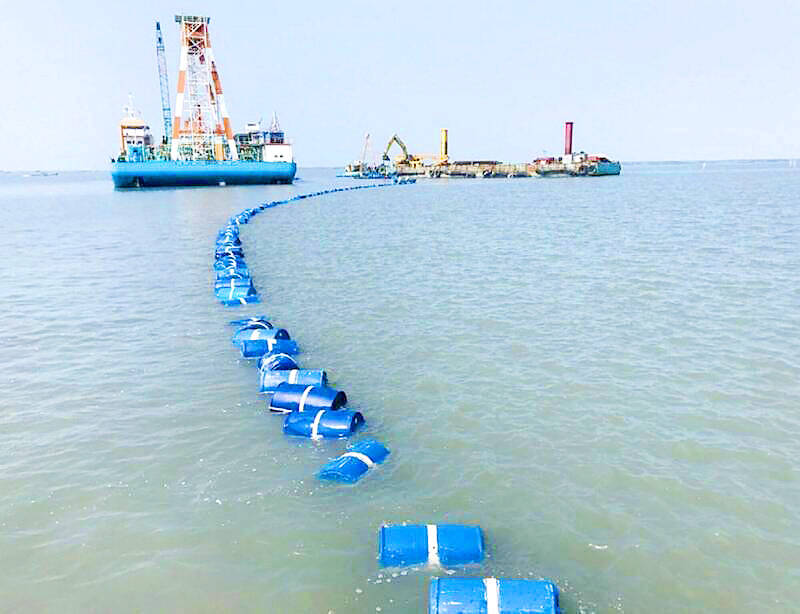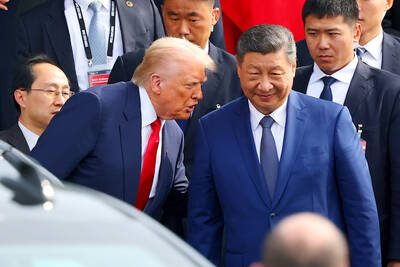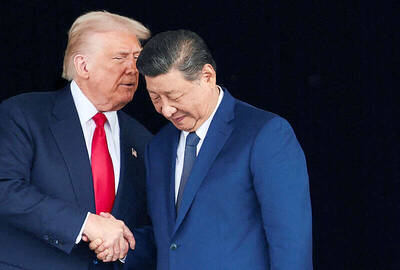The government is planning to build an Internet cable terminal in Tainan and lay two additional undersea cables to boost telecommunications resiliency, an official familiar with the matter said yesterday, speaking on condition of anonymity.
Two subsea Internet cables connecting Lienchiang County to Taiwan proper were severed in separate incidents allegedly involving a Chinese trawler and a cargo ship in early February.
The nation’s submarine cables are unevenly distributed in favor of northern Taiwan, with cable landing points in New Taipei City’s Bali (八里) and Tamsui (淡水) districts, and Yilan County’s Toucheng Township (頭城), while Taiwan’s fourth cable landing point is in Pingtung County’s Fangshan Township (枋山), the source said.

Photo courtesy of Taiwan Power Co
Southern Taiwan entirely depends on the three cables ending in Fangshan, they said.
The National Science Council has ordered the National Center for High-Performance Computing to plan a cloud server center and Internet cable landing point in Tainan, as well as a backup auxiliary node in Taichung, to bolster redundancy and security, they said.
The project is scheduled to be completed by 2025, they said, adding that private-sector entities have expressed interest.
Separately, the construction of the Southeast Asia-Japan 2 submarine cable system connecting Taiwan, Japan, South Korea and Singapore is expected to be completed by the end of this year, they said.
The system includes landing points in Tamsui and Fangshan, they said, adding that the operators decided to set up two landing points to ensure that a failure of one of them would not disconnect Taiwan from the system.
Moreover, the Apricot subsea cable, which is expected to go online late next year, has been rerouted to bypass the Philippines and Indonesia to enhance its security, they said.
Overall, 14 submarine cables link Taiwan with other countries, and the government is aware that China might try to attack them, they said.
However, several third countries also route Internet traffic through those cables, and Taipei and Beijing are aware that these countries have an interest in them remaining intact, they added.
Repairs on one of the cables connecting Lienchiang County were finished at the end of last month, restoring the outlying county’s regular Internet access, they said.
The National Communications Commission and the Cyber Security Center said Taiwan reported 51 service disruptions of subsea cables between 2018 and last year.
The disruptions include 18 that affected the Toucheng-Fanghsang dual landing points, 22 that affected the Tamsui landing point and 11 that affected the Bali landing point.
These events include 25 cases that were caused by trawler netting or ship anchors, 12 were caused by geological events, three were caused by equipment failure or wear on the cables, six were caused by scheduled maintenance and two were caused by errors made during maintenance.

CALL FOR SUPPORT: President William Lai called on lawmakers across party lines to ensure the livelihood of Taiwanese and that national security is protected President William Lai (賴清德) yesterday called for bipartisan support for Taiwan’s investment in self-defense capabilities at the christening and launch of two coast guard vessels at CSBC Corp, Taiwan’s (台灣國際造船) shipyard in Kaohsiung. The Taipei (台北) is the fourth and final ship of the Chiayi-class offshore patrol vessels, and the Siraya (西拉雅) is the Coast Guard Administration’s (CGA) first-ever ocean patrol vessel, the government said. The Taipei is the fourth and final ship of the Chiayi-class offshore patrol vessels with a displacement of about 4,000 tonnes, Lai said. This ship class was ordered as a result of former president Tsai Ing-wen’s (蔡英文) 2018

UKRAINE, NVIDIA: The US leader said the subject of Russia’s war had come up ‘very strongly,’ while Jenson Huang was hoping that the conversation was good Chinese President Xi Jinping (習近平) and US President Donald Trump had differing takes following their meeting in Busan, South Korea, yesterday. Xi said that the two sides should complete follow-up work as soon as possible to deliver tangible results that would provide “peace of mind” to China, the US and the rest of the world, while Trump hailed the “great success” of the talks. The two discussed trade, including a deal to reduce tariffs slapped on China for its role in the fentanyl trade, as well as cooperation in ending the war in Ukraine, among other issues, but they did not mention

HOTEL HIRING: An official said that hoteliers could begin hiring migrant workers next year, but must adhere to a rule requiring a NT$2,000 salary hike for Taiwanese The government is to allow the hospitality industry to recruit mid-level migrant workers for housekeeping and three other lines of work after the Executive Yuan yesterday approved a proposal by the Ministry of Labor. A shortage of workers at hotels and accommodation facilities was discussed at a meeting of the legislature’s Transportation Committee. A 2023 survey conducted by the Tourism Administration found that Taiwan’s lodging industry was short of about 6,600 housekeeping and cleaning workers, the agency said in a report to the committee. The shortage of workers in the industry is being studied, the report said. Hotel and Lodging Division Deputy Director Cheng

‘SECRETS’: While saying China would not attack during his presidency, Donald Trump declined to say how Washington would respond if Beijing were to take military action US President Donald Trump said that China would not take military action against Taiwan while he is president, as the Chinese leaders “know the consequences.” Trump made the statement during an interview on CBS’ 60 Minutes program that aired on Sunday, a few days after his meeting with Chinese President Xi Jinping (習近平) in South Korea. “He [Xi] has openly said, and his people have openly said at meetings, ‘we would never do anything while President Trump is president,’ because they know the consequences,” Trump said in the interview. However, he repeatedly declined to say exactly how Washington would respond in